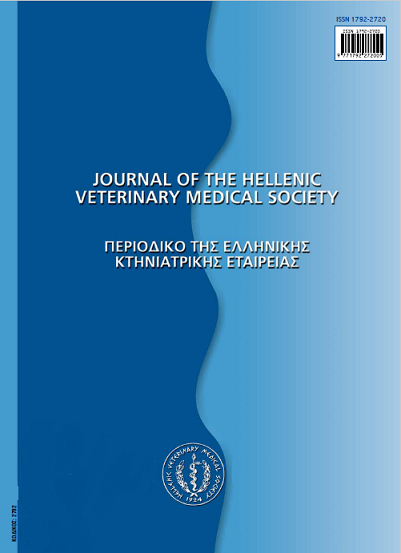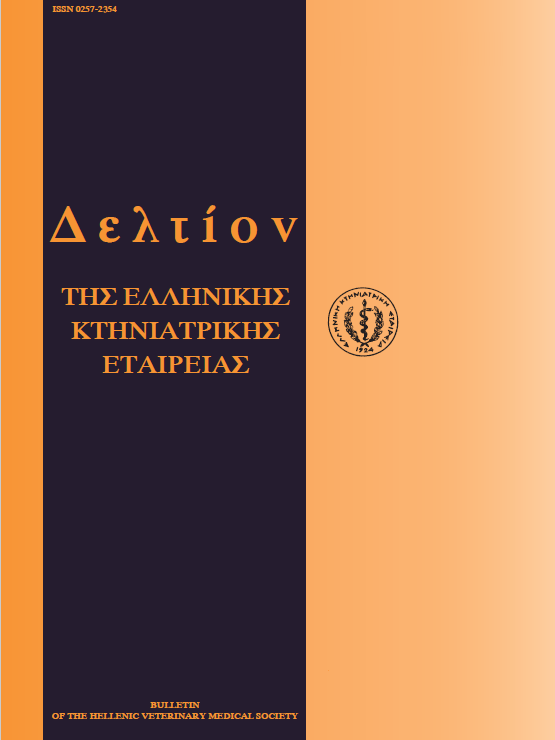Διερεύνηση της σχέσης μεταξύ πληθυσμιακής σύνθεσης των μελισσιών που εκτρέφονται στην Κρήτη και της ανθεκτικότητας τους ενάντια στο άκαρι Acarapis woodi, Rennie

Περίληψη
Προσδιορίσθηκε η πληθυσμιακή σύνθεση μελισσιών που προέκυψαν στην Κρήτη από τη διασταύρωση της τοπικής μέλισσας Apis mellifera adami και των φυλών Apis melliferamacedonica και Apis melliferaligustica. Ερευνήθηκε η πιθανή σχέσητης πληθυσμιακής σύνθεσης με την ανθεκτικότητα αυτών των πληθυσμών στο άκαρι Acarapis woodi παθογόνο αίτιο της τραχειακής ακαρίασης. Από μελισσοκομείο 45 μελισσιών προσβεβλημένο από τραχειακή ακαρίαση, το οποίο παρουσίαζε έντονη πολυμορφία στα μορφολογικά γνωρίσματα του πληθυσμού, πάρθηκαν δείγματα 50 μελισσών και εξετάσθηκαν ως προς: α) Τα μορφολογικά και τα μορφομετρικά χαρακτηριστικά των μελισσών κάθε δείγματος, β)Το ποσοστό των μολυσμένων μελισσών, τη μονόπλευρη ή αμφίπλευρη μόλυνση των τραχειών και την ένταση της μόλυνσης των τραχειών κάθε μολυσμένου δείγματος. Μετά την εξέταση τα μελίσσια κατατάχθηκαν σε τέσσερις ομάδες, ανάλογα με τα μορφολογικά και τα μορφομετρικά χαρακτηριστικά των μελισσών που υπερτερούσαν στη σύνθεση κάθε δείγματος : Ομάδα Ι, υβρίδια της Apis melliferamacedonica, ομάδα Π, υβρίδια της Apis melliferaligustica, ομάδα III, υβρίδια της Apis melliferaligusticaτύπος "Brightyellow" και ομάδα IV ποικιλόμορφα υβρίδια. Από την εξέταση των τραχειών διαπιστώθηκε ότι η πληθυσμιακή σύνθεση επηρεάζει την ανθεκτικότητα των μελισσιών. Τα μελίσσια της Ομάδας Ι, που αποτελούνταν στο μεγαλύτερο ποσοστό τους από μέλισσες με χαρακτηριστικά της Α. m. macedonica παρουσίασαν την υψηλότερη ανθεκτικότητα στο Α. woodi, αντίθετα αυτά της ομάδας III, που υπερτερούσαν οιμέλισσες με τα χαρακτηριστικά του τύπου "bright yellow" της Α. m.ligustica παρουσίασαν μεγάλη ευαισθησία. Τα μελίσσια των δυο άλλων ομάδων παρουσίασαν σχετικά μεγάλη ανθεκτικότητα, μικρότερη όμως αυτής της Α. m. macedonica.
Λεπτομέρειες άρθρου
- Πώς να δημιουργήσετε Αναφορές
-
LIAKOS (Β. ΛΙΑΚΟΣ) B. (2018). Διερεύνηση της σχέσης μεταξύ πληθυσμιακής σύνθεσης των μελισσιών που εκτρέφονται στην Κρήτη και της ανθεκτικότητας τους ενάντια στο άκαρι Acarapis woodi, Rennie. Περιοδικό της Ελληνικής Κτηνιατρικής Εταιρείας, 53(1), 56–61. https://doi.org/10.12681/jhvms.15359
- Τεύχος
- Τόμ. 53 Αρ. 1 (2002)
- Ενότητα
- Research Articles

Αυτή η εργασία είναι αδειοδοτημένη υπό το CC Αναφορά Δημιουργού – Μη Εμπορική Χρήση 4.0.
Οι συγγραφείς των άρθρων που δημοσιεύονται στο περιοδικό διατηρούν τα δικαιώματα πνευματικής ιδιοκτησίας επί των άρθρων τους, δίνοντας στο περιοδικό το δικαίωμα της πρώτης δημοσίευσης.
Άρθρα που δημοσιεύονται στο περιοδικό διατίθενται με άδεια Creative Commons 4.0 Non Commercial και σύμφωνα με την άδεια μπορούν να χρησιμοποιούνται ελεύθερα, με αναφορά στο/στη συγγραφέα και στην πρώτη δημοσίευση για μη κερδοσκοπικούς σκοπούς.
Οι συγγραφείς μπορούν να καταθέσουν το άρθρο σε ιδρυματικό ή άλλο αποθετήριο ή/και να το δημοσιεύσουν σε άλλη έκδοση, με υποχρεωτική την αναφορά πρώτης δημοσίευσης στο J Hellenic Vet Med Soc
Οι συγγραφείς ενθαρρύνονται να καταθέσουν σε αποθετήριο ή να δημοσιεύσουν την εργασία τους στο διαδίκτυο πριν ή κατά τη διαδικασία υποβολής και αξιολόγησής της.



